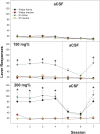The Rewarding and Anxiolytic Properties of Ethanol within the Central Nucleus of the Amygdala: Mediated by Genetic Background and Nociceptin
- PMID: 32527792
- PMCID: PMC7430446
- DOI: 10.1124/jpet.119.262097
The Rewarding and Anxiolytic Properties of Ethanol within the Central Nucleus of the Amygdala: Mediated by Genetic Background and Nociceptin
Abstract
In humans, alcohol is consumed for its rewarding and anxiolytic effects. The central nucleus of the amygdala (CeA) is considered a neuronal nexus that regulates fear, anxiety, and drug self-administration. Manipulations of the CeA alter ethanol (EtOH) consumption under numerous EtOH self-administration models. The experiments determined whether EtOH is reinforcing/anxiolytic within the CeA, whether selective breeding for high alcohol consumption alters the rewarding properties of EtOH in the CeA, and whether the reinforcing/anxiolytic effects of EtOH in the CeA are mediated by the neuropeptides corticotropin-releasing factor (CRF) and nociceptin. The reinforcing properties of EtOH were determined by having male Wistar and Taconic alcohol-preferring (tP) rats self-administer EtOH directly into the CeA. The expression of anxiety-like behaviors was assessed through multiple behavioral models (social interaction, acoustic startle, and open field). Coadministration of EtOH and a CRF1 antagonist (NBI35965) or nociceptin on self-administration into the CeA and anxiety-like behaviors was determined. EtOH was self-administered directly into the lateral CeA, and tP rats self-administered a lower concentration of EtOH than Wistar rats. EtOH microinjected into the lateral CeA reduced the expression of anxiety-like behaviors, indicating an anxiolytic effect. Coadministration of NBI35965 failed to alter the rewarding/anxiolytic properties of EtOH in the CeA. In contrast, coadministration of the nociceptin enhanced both EtOH reward and anxiolysis in the CeA. Overall, the data indicate that the lateral CeA is a key anatomic location that mediates the rewarding and anxiolytic effects of EtOH, and local nociceptin receptors, but not local CRF1 receptors, are involved in these behaviors. SIGNIFICANCE STATEMENT: Alcohol is consumed for the stimulatory, rewarding, and anxiolytic properties of the drug of abuse. The current data are the first to establish that alcohol is reinforcing and anxiolytic within the lateral central nucleus of the amygdala (CeA) and that the nociceptin system regulates these effects of alcohol within the CeA.
Copyright © 2020 by The American Society for Pharmacology and Experimental Therapeutics.
Figures








References
-
- Boehm SL, II, Piercy MM, Bergstrom HC, Phillips TJ. (2002) Ventral tegmental area region gove-rns GABA(B) receptor modulation of ethanol-stimulated activity in mice. Neuroscience 115:185–200. - PubMed
-
- Chieng BC, Christie MJ, Osborne PB. (2006) Charaterization of neurons in the rat central nucleus of the amygdala: cellular physiology, morphology, and opioid sensitivity. J Comp Neurol 497:910–927. - PubMed
-
- Ciocchi S, Herry C, Grenier F, Wolff SB, Letzkus JJ, Vlachos I, Ehrlich I, Sprengel R, Deisseroth K, Stadler MB, et al. (2010) Encoding of conditioned fear in central amygdala inhibitory circuits. Nature 468:277–282. - PubMed
Publication types
MeSH terms
Substances
Grants and funding
LinkOut - more resources
Full Text Sources

